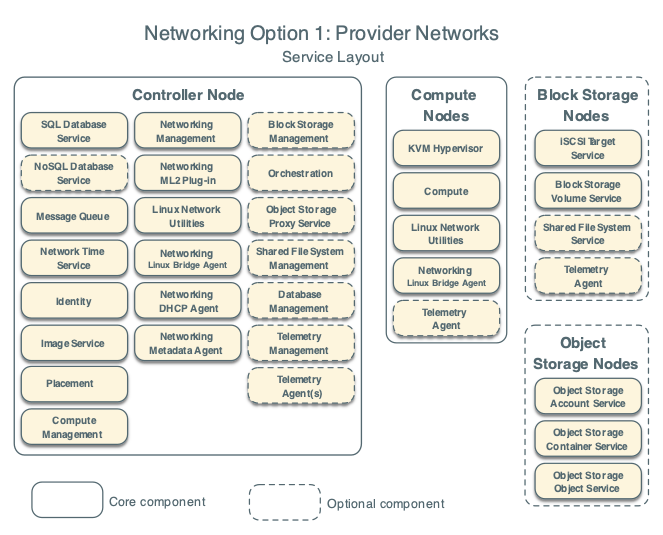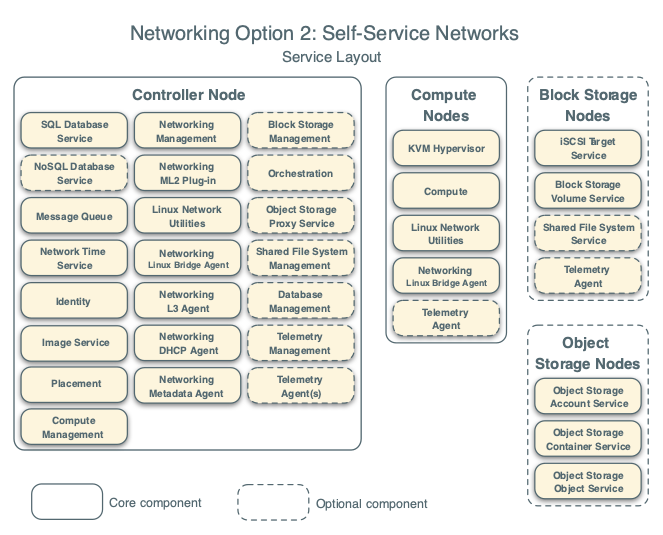সংক্ষিপ্ত বিবরণ¶
শব্দটি: ওপেনস্ট্যাক প্রকল্পটি একটি ওপেন সোর্স ক্লাউড কম্পিউটিং প্ল্যাটফর্ম যা সকল ধরণের ক্লাউড ইনভারমেন্টকে সার্পোট করে। প্রকল্পটির লক্ষ্য সাধারণ বাস্তবায়ন, বিশাল পরিমাণের স্কেলাবিলিটি এবং বৈশিষ্ট্যগুলির একটি সমৃদ্ধ সেট। বিশ্বজুড়ে ক্লাউড কম্পিউটিং বিশেষজ্ঞরা এই প্রকল্পে অবদান রাখেন।
ওপেনস্ট্যাক একটি প্রোভাইডার করে: শব্দ: `ইনফ্রাস্ট্রাকচার-এ-এ-সার্ভিস (আইএএএস) complement বিভিন্ন পরিপূরক সার্ভিসের মাধ্যমে সমাধান করে । প্রতিটি সার্ভিস একটি শর্ত দেয়: অ্যাপ্লিকেশন প্রোগ্রামিং ইন্টারফেস (এপিআই) যা এই সংহতকরণকে সহজতর করে।
এই গাইডটিতে ওপেনস্ট্যাকের নতুন ব্যবহারকারীদের জন্য পর্যাপ্ত লিনাক্স অভিজ্ঞতার জন্য উপযুক্ত একটি কার্যকরী উদাহরণ আর্কিটেকচার ব্যবহার করে প্রধান ওপেনস্ট্যাক সার্ভিসের পদক্ষেপে মোতায়েনের ব্যবস্থা রয়েছে। এই গাইডটি উত্পাদন সিস্টেমের ইনস্টলেশনের জন্য ব্যবহার করার উদ্দেশ্যে নয়, ওপেনস্ট্যাক সম্পর্কে শেখার উদ্দেশ্যে একটি ন্যূনতম প্রুফ-অফ-ধারণা তৈরি করা
এই ওপেনস্ট্যাক সার্ভিসগুলির বেসিক ইনস্টলেশন, কনফিগারেশন, পরিচালনা এবং সমস্যা সমাধানের সাথে পরিচিত হওয়ার পরে, আপনাকে একটি প্রোডাকশন আর্কিটেকচার ব্যবহার করে স্থাপনার দিকে নিচের পদক্ষেপগুলি বিবেচনা করা উচিত:
Determine and implement the necessary core and optional services to meet performance and redundancy requirements.
Increase security using methods such as firewalls, encryption, and service policies.
Use a deployment tool such as Ansible or Puppet to automate deployment and management of the production environment. The OpenStack project has a couple of deployment projects with specific guides per version: - 2025.2 (Flamingo) release - 2025.1 (Epoxy) release - 2024.2 (Dalmatian) release
Example architecture¶
The example architecture requires at least two nodes (hosts) to launch a basic virtual machine or instance. Optional services such as Block Storage and Object Storage require additional nodes.
গুরুত্বপূর্ণ
The example architecture used in this guide is a minimum configuration, and is not intended for production system installations. It is designed to provide a minimum proof-of-concept for the purpose of learning about OpenStack. For information on creating architectures for specific use cases, or how to determine which architecture is required, see the Architecture Design Guide.
This example architecture differs from a minimal production architecture as follows:
Networking agents reside on the controller node instead of one or more dedicated network nodes.
Overlay (tunnel) traffic for self-service networks traverses the management network instead of a dedicated network.
For more information on production architectures for Pike, see the Architecture Design Guide, OpenStack Networking Guide for Pike, and OpenStack Administrator Guides for Pike.
For more information on production architectures for Queens, see the Architecture Design Guide, OpenStack Networking Guide for Queens, and OpenStack Administrator Guides for Queens.
For more information on production architectures for Rocky, see the Architecture Design Guide, OpenStack Networking Guide for Rocky, and OpenStack Administrator Guides for Rocky.

Hardware requirements¶
Controller¶
The controller node runs the Identity service, Image service, Placement service, management portions of Compute, management portion of Networking, various Networking agents, and the Dashboard. It also includes supporting services such as an SQL database, message queue, and NTP.
Optionally, the controller node runs portions of the Block Storage, Object Storage, Orchestration, and Telemetry services.
The controller node requires a minimum of two network interfaces.
Compute¶
The compute node runs the hypervisor portion of Compute that operates instances. By default, Compute uses the KVM hypervisor. The compute node also runs a Networking service agent that connects instances to virtual networks and provides firewalling services to instances via security groups.
You can deploy more than one compute node. Each node requires a minimum of two network interfaces.
ব্লক স্টোরেজ¶
The optional Block Storage node contains the disks that the Block Storage and Shared File System services provision for instances.
For simplicity, service traffic between compute nodes and this node uses the management network. Production environments should implement a separate storage network to increase performance and security.
You can deploy more than one block storage node. Each node requires a minimum of one network interface.
Object Storage¶
The optional Object Storage node contain the disks that the Object Storage service uses for storing accounts, containers, and objects.
For simplicity, service traffic between compute nodes and this node uses the management network. Production environments should implement a separate storage network to increase performance and security.
This service requires two nodes. Each node requires a minimum of one network interface. You can deploy more than two object storage nodes.
নেটওয়ার্কিং¶
Choose one of the following virtual networking options.
Networking Option 1: Provider networks¶
The provider networks option deploys the OpenStack Networking service in the simplest way possible with primarily layer-2 (bridging/switching) services and VLAN segmentation of networks. Essentially, it bridges virtual networks to physical networks and relies on physical network infrastructure for layer-3 (routing) services. Additionally, a DHCP service provides IP address information to instances.
The OpenStack user requires more information about the underlying network infrastructure to create a virtual network to exactly match the infrastructure.
সতর্কতা
This option lacks support for self-service (private) networks, layer-3 (routing) services, and advanced services such as LBaaS and FWaaS. Consider the self-service networks option below if you desire these features.

Networking Option 2: Self-service networks¶
The self-service networks option augments the provider networks option with layer-3 (routing) services that enable self-service networks using overlay segmentation methods such as VXLAN. Essentially, it routes virtual networks to physical networks using NAT. Additionally, this option provides the foundation for advanced services such as LBaaS and FWaaS.
The OpenStack user can create virtual networks without the knowledge of underlying infrastructure on the data network. This can also include VLAN networks if the layer-2 plug-in is configured accordingly.

